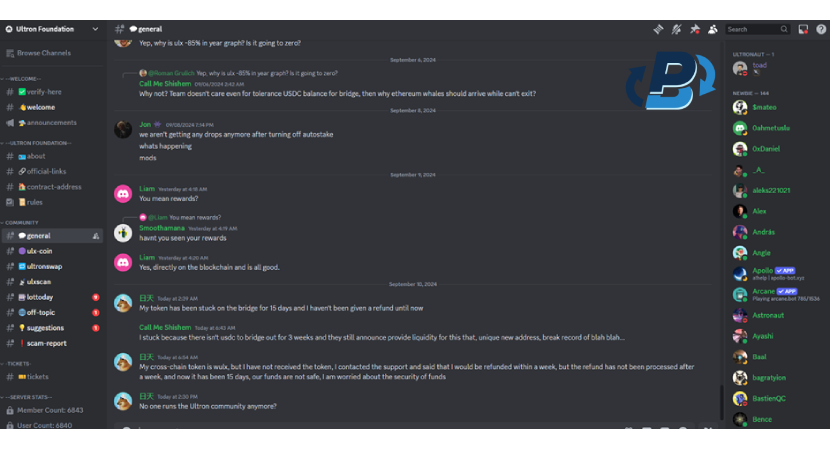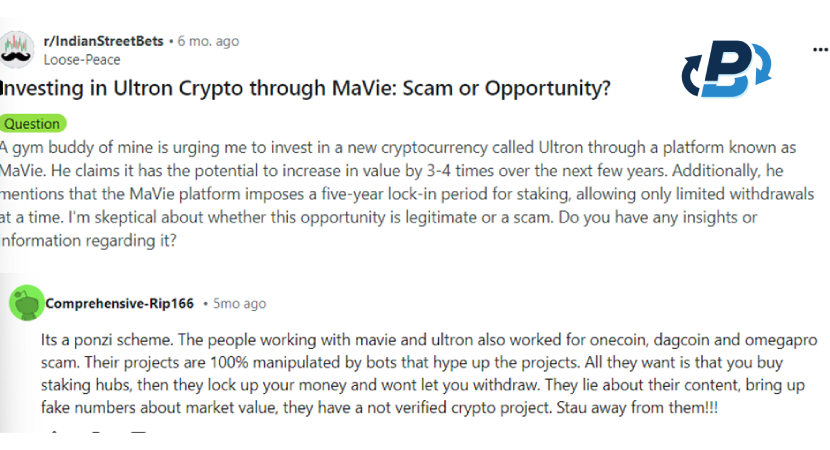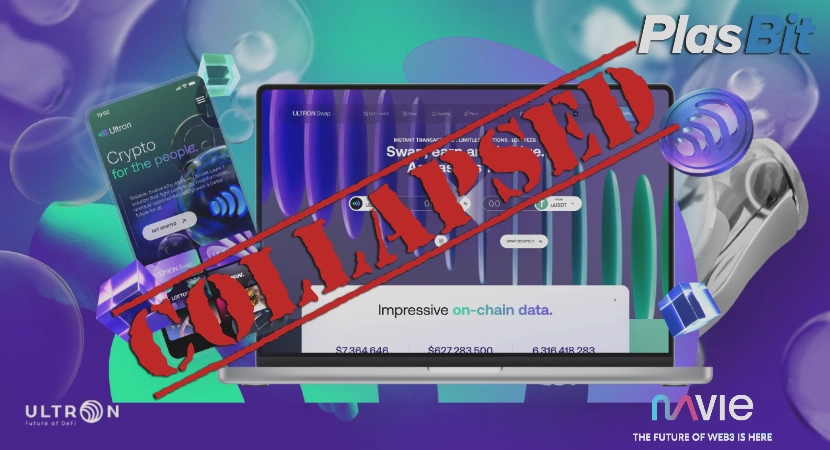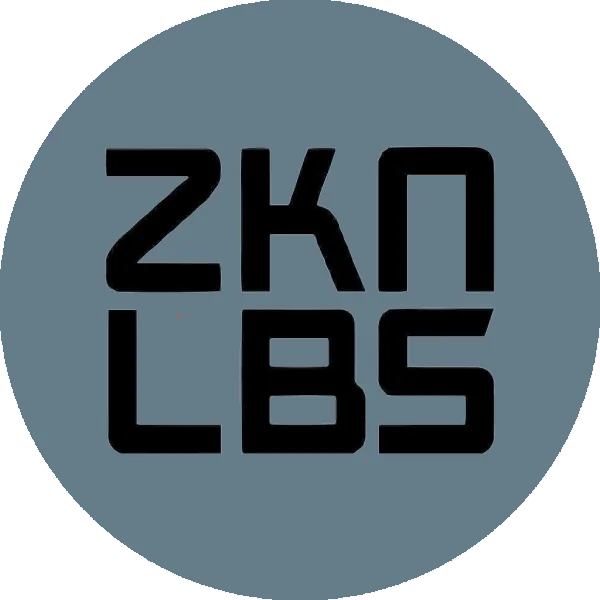Scams are common in crypto projects, and many investors have been trapped by misleading advertising and unrealistic promises. One remarkable case study is Ultron ($ULX), founded by Shukhrat Shadibekov in 2022 and backed by Mavie, founded by Michal Prazenica. But why is Ultron Mavie a Ponzi scam? There are many red flags showing that Ultron Mavie is a Ponzi scam, including multi-level marketing (MLM), team members already involved in previous pyramid schemes (such as Onecoin and others), a 5-year locking period for staking, unrealistic promises of returns, bots and fake engagement to manipulate hype, unnecessary complications with bridges and wrapped tokens to keep you from selling your assets, continuous delays and failure to implement promised developments, bans on community members asking for updates and explanations, tokens concentrated in the hands of the team, project headquarters in a protected tax haven, misleading and ambiguous influencers, and more. All these factors contribute to making us believe that the project is a “classic” Ponzi scam based on pyramid schemes and multi-level marketing.
In this detailed research, PlasBit will explore Ultron in detail to understand how they are scamming people and educate users about the risks of joining crypto projects that are actually based on pyramid schemes and unrealistic earning promises. Remember, before investing in any kind of crypto project, DYOR (Do your own research) and verify the most common red flags.

Is Ultron Mavie a Ponzi Scam? Analyzing the Red Flags
There are so many red flags in this project, and we’re quite surprised that so many crypto enthusiasts fell into their trap. The project keeps attracting new people, and once you’re in, you cannot sell or withdraw the funds invested in a classical Ponzi scam. We hope that this research will help you and other investors carefully evaluate the risks and critical red flags of Ultron so that you can avoid investing in it and preserve your capital without giving your funds to unscrupulous scammers. So, let’s start analyzing the red flags of this crypto project.
Multi-Level Marketing (MLM)
The most evident red flag is the use of Multi-Level Marketing (MLM) to promote Ultron and reach new investors. This type of marketing scheme incentivizes investors to recruit others by providing a commission for every new person who joins the project, creating a pyramid scheme in which the first investors earn from the funds of the new investors. The majority of profits flow at the top of the pyramid, and the only people who actually make profits are the team and the first investors. MLM schemes are usually linked to Ponzi scams, as in this case, and the project can survive only with a continuous influx of new investors and funds to sustain payouts to early investors. As you can understand, if the project doesn’t generate revenue from useful services or products, and the only cash flow is from new investors, the system will inevitably collapse on itself, leaving the people at the bottom of the pyramid with significant irrecuperable losses. Avoid investing in projects that use MLM schemes because, as in the case of Ultron, they are likely a Ponzi scam, and you will lose your money. That’s not all, because if you invite your friends to the projects, you’ll be responsible also for the loss of the people you brought in. Avoid MLM schemes at all costs.

Team members involved in previous scams
Mavie is the platform that promotes and backs Ultron ($ULX), allowing it to implement a multi-level marketing structure. The team Mavie is led by Micheal Pranzica, who is already involved in previous scams such as Xaurum and CoinSpace, and Mavie is basically focused only on promoting suspicious tokens and projects through multi-level marketing and pyramid schemes. His involvement in previous scams underscores the risks of trusting such an individual, and only people who do not conduct DYOR don’t notice it.
The founder of Ultron is Shukhrat Shadibekov, who had a previous company called Mavia (is it a coincidence?), and the CMO is Jacop Kabus, another member who was involved in Xaurum, an already mentioned scam project that went from over $1700 to under a penny in under a short time eight years ago (2016). Another team member, the main developer, Siarhei Kudrautsau, was involved in another crypto scam token, World Bit Bank, and other suspicious members, such as Domen Vidergar, Klemen Nicoletti, and Chisti Chitic, linked to many crypto scams are part of Ultron and Mavie. These are definitely enormous, inconfutable big red flags, and we highly recommend not investing in any projects that have team members involved in previous serious scams.
In most crypto scams, the team is anonymous so that they can avoid facing legal actions if they commit crimes and steal money from investors, but in this case, most of the team members are public to increase the reputation and perceived trust of the project. However, most of them moved to Dubai, where the legislation protects them from legal actions and criminal charges. Additionally, Mavie's legal office is in the Virgin Islands, allowing them to hide their funds and not pay taxes at all. As you can understand, we’re not analyzing a “classic” scam in which the team members are disorganized, and the scam is easily recognizable, but this is a very well-organized criminal organization that leverages multi-level marketing and token sales to steal money from investors without the possibility of facing legal consequences. They created a detailed plan to avoid prison and keep scamming people without concerns or preoccupations. In another analysis regarding Ultron Mavie, we also found that their team actually wanted to pay $1,500 to an Italian crypto information website to remove the article and delete the proof of their scam. It’s crazy, and the Mavie/Ultron team will probably offer us the same proposal to remove this article.
5-Years locking period for staking
If you’re wondering how they “legally” prevent you from withdrawing your money and cashing out your investment (before it’s too late), here you will find the answer. As you should know, staking implies locking your asset for a determined period of time to ensure network stability and avoid massive withdrawals without forewarning. Usually, the blockchain implements an un-bonding period (a duration during which staked assets remain locked before they can be withdrawn), and, for example, in Ethereum, it is 15 days; in Solana, it is 3 days; in Cosmos, it is 21 days, and in Cardano, you can unstake your ADA instantaneously. It’s funny to discover that, in Ultron, the minimum staking period is 5 years, lmao, which means that you cannot withdraw your assets before waiting for years. It’s crazy, and the staking period has been conceived in this way to ensure you basically cannot withdraw your assets and make it impossible to exit the project. Long and complex lock-up periods are common in Ponzi schemes, where investors have an illusion of profitability, while in reality, it serves only to prevent mass withdrawals that could expose the scam clearly.
Unrealistic promises of returns
Considering that the average return of the S&P 500 in the last 30 years is around 10% and that only a very small percentage of traders and hedge funds can perform a better percentage over the long term, promising higher, secure returns is usually associated with misleading promotion and, consequently, scams. Ultron, on its website, created an interactive chart in which you can select the amount of USDT invested and the staking plan to discover how much return you should get from your investment. They basically auto-condemn themselves by showing unrealistic and unsustainable earnings plans. Here is the chart they show:

They promise that by investing 1,500 USD, in 5 years, you will get 6,157.57 USD, with a return of 310.5%, meaning an average return of around 32% yearly. It’s likely impossible to give investors back this percentage each year, especially considering that the project has no active and profitable revenue income, and all the rewards are based on the funds of new investors. Additionally, it doesn’t consider that the token price could drop to zero (as it’s already happening), giving investors misleading information. This is a very serious issue, and every investor should understand that any project that guarantees secure returns, especially promising 32% yearly, it’s likely a scam: It’s impossible and unsustainable. However, many inexperienced investors have been trapped in their promises and are consistently losing money without the possibility of cashing out. The Ultron and Mavie team should be ashamed and face legal consequences for this.
Bots and fake engagement
Another clear red flag is the use of fake engagement on social media and communities and the implementation of bots to fakely increase the trading volume. The manipulation of social media engagement is intended to give the fake impression that the project is widely supported by a large number of people, aiming to create “social proofs” that manipulate new investors, making them believe that the project is legitimate. Such deceptive practices are common in scams, and help the corrupt team to create momentum, hype, and FOMO, creating an air of legitimacy and draining in new unsuspected investors. That’s the final goal of these Ponzi schemes: To last as long as possible by keeping investors flowing in who can pay the rewards to the initial investors, in a (semi) endless loop. The longer the project lasts, the more the team earns, but it cannot last long. Once the project can no longer pay the investors (e.g., when they can withdraw their assets), the scam will clearly come to light, and Ultron will collapse in on itself. Fake engagement is quite clear to be recognized since, for example, comments are AI-generated and quite similar and repetitive, the posts usually have a fixed amount of interactions (likes, views, and retweets), and the followers are inflated, often using Asian-based services that pump them with bots and/or purchased low-quality profiles with no (or a few) followers. Additionally, to create momentum on crypto tokens’ analysis tools, Ultron uses bots to inflate the trading volume of the token $ULX, making people believe that there is a lot of active trading when, in reality, it is mainly the same actor with multiple bots that increase the volume artificially, as also usually happens in pump-and-dump schemes. If that’s not all, this practice is also commonly used in wash trading, in which criminals clean up illicit funds by trading them and making them legitimate, although we have no proof of this and can only state that this practice is very common in scam projects.

Overcomplicated Whitepaper to trick investors
Scam projects usually create overcomplicated, long, complex, and incomprehensible whitepapers to trick investors and make them believe that the project is run by experts in the field who are solving difficult problems through advanced solutions. However, the best and most legitimate projects don’t need to overcomplicate things, and they should clearly write down the problem they want to address and the solutions they want to implement. On the Ultron Whitepaper (if you’re interested we advise you to download it before they remove it and delete/edit the scam proofs), they have not updated since 2022 (another big red flag), they use complex jargon and make the text longer than necessary, digressing and overcomplicating things, to trick investors so that A) they do not read all the whitepaper, B) They are confused because don’t have the technical knowledge to understand it, C) They think the team is skilled and ready to solve a complex problem. We recommend always reading the whitepaper of a crypto project before investing in it and applying critical thinking to understand if they are really solving a real-demanded problem with useful concrete solutions or if they are only overcomplicating things to mislead and increase the positive perception of the project.
Fake promises and delays in development
In the whitepaper, Ultron made a lot of promises, including numerous utilities and benefits that they should have released over the past years. However, as usually happens in scam projects, the delivery of the promises has been delayed. In this project, there is an evident pattern of continuously delaying and failing to deliver on promised developments, and this stalling tactic is another classic feature of Ponzi schemes, where team members buy time to attract more investors while avoiding scrutiny. As long as they can keep promising future developments, they can keep the scheme alive and keep stealing money from new investors, as happens in slow rug pulls. You can simply check the following roadmap and compare it with released development to understand that most of the promises made have not been delivered (and will probably never be delivered).

Banning community members and deleting comments on social media
Another classic behavior of scam projects is banning community members who ask questions and raise concerns about the missing deliveries of the promises. Having a suspicious community of angry investors who ask for news about developments and promises is not positive for scammers since it could affect the trust of new investors. Consequently, there is tyrannic management in the community, and every person who asks uncomfortable questions is labeled as a “fudder” and banned from the community. However, if you invest money in a project, you have the right to know and understand what’s going on, especially if the team keeps delaying promises and does not deliver in time following their roadmap. In Ultron, in fact, if you check their Discord community, you can easily see that there is very little activity, and nobody asks questions about the project. If you do so, your comment will be deleted, and you will be banned for life. When the project starts to collapse, as in Ultron, you can also see that the moderators and the team do not answer the community anymore, leaving it abandoned to itself, as demonstrated in the following screenshot. Additionally, you can also see that all the premium features they paid for during the promotion phase, such as the customized banner, the custom bot, etc., have disappeared since the team has no more interest in making the community attractive. The scam is already clear to most of the people.

Mavie Global & Ultron Desist Order from Quebec’s AMF
In confirmation of our existing belief, we recently found an order to cease activity for various companies linked to the team behind this project, such as Mavie Lab Ltd, Ultron Technologies Incorporated, FlipMe, LottoDay, and three Multi-Level Marketing Canadian serial promoters, Nick Lemay, Stephane Plante and Nathalie Mercier. The desist order comes only for Canadian residents, as the Canadian AMF ordered, but it’s very plausible that a similar order will also come from other countries very soon for other team members. Ultron, FlipMe, and LottoDay are all companies controlled by Mavie Global, and they are all pyramid schemes based on Ponzi scams. Additionally, the three “influencers”, Nick Lemay, Stephanie Plante, and Nathalie Mercier, accused of being complicit in the scams, already participated in other fraudulent MLM schemes, such as Be (aka Melius), Validus, and Safir, highlighting a recurring pattern and a clear familiarity in promoting scams and unsafe projects.
Always Verify Feedback from other Users
Before investing in any crypto project, verify the feedback of users already involved in it.
Trustpilot Reviews
With easy research on Trustpilot, for example, you can easily verify that many users reported the company as a scam. The team didn’t reply to users' complaints; they didn’t give them the staked tokens as promised, there is no real headquarters, the NFTs are not registered on the blockchain, the commission rate changed suddenly without any specific reason or motivation, people cannot withdraw their assets, and many other issues. Remember also to check reviews of the company (and the companies linked to it) before making any investment. With a simple research of about 5 minutes, you can save your funds and avoid giving them to scammers.

Research the Project on Reddit
Another good platform to research the project you’re evaluating is Reddit. On Reddit, people can ask public questions, and there are usually experts ready to research and answer your questions and clarify your doubts. For example, in this Ultron Reddit post, a user asked if investing in Ultron via Mavie could be a scam or an opportunity. As usual, the project was suggested to him through word-of-mouth by a friend who was probably looking to increase his revenue by referring new investors. Most of the comments, fortunately, answered that the project is a scam and that, as we already stated in this research, many team members were already involved in previous scams and would not let you withdraw your money. Researching information in communities and online forums is very useful to avoid being scammed by well-known Ponzi scams and misleading projects.

Is Ultron Mavie a Ponzi Scam? Watch out for the Red Flags
After conducting this research, we can confirm that Ultron Mavie is a Ponzi scam. There are so many red flags, and considering it “safe and legit” would be an insult to all the legit and real crypto projects that are really building and innovating in the sector. We hope that this PlasBit research will help you avoid being trapped in this and other Ponzi scams. Never trust suspicious influencers or projects that promise unrealistic returns, and, in general, never invest in projects that you don’t understand. Additionally, multi-level marketing (MLM) should be considered the major red flag for pyramid Ponzi schemes and avoided at all costs. Ponzi schemes can pay off early investors only through the funds of new investors, and once the project cannot get a new influx of capital and people, it collapses on itself, making it impossible for most of the investors to recover their initial capital. If something is too good to be true, it probably is: Prioritize DYOR (Do your own research) and apply critical thinking to easily discover if a project is a scam. At PlasBit, we’ll be always here to create educational content that can help you make conscious and pondered decisions. We do not rely on or depend on third parties, and we’re working hard to create a better world in which people, through financial education and self-custody, can reach the financial freedom they deserve. We wish you a safe journey in Web3, and we recommend one last time to avoid pyramid schemes at all costs.








